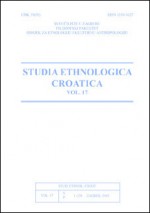Košaraštvo u sustavu kružnog toka kulture
Basket Weaving in the System of Circle Flow of Culture
Author(s): Tomislav PletenacSubject(s): Fine Arts / Performing Arts, Customs / Folklore, Cultural Anthropology / Ethnology
Published by: Sveučilište u Zagrebu, Filozofski fakultet
Keywords: circle flow of culture; cultural studies; design; woven baskets; position of the researcher;
Summary/Abstract: This text is trying to analyze basket weaving inside the circle flow of culture, a theoretical notion constructed within the field of cultural studies. Three levels of the existence of the product are analyzed: production, consumption and representation. For a number of reasons, Croatian ethnology has rarely dealt with the formation of products as a form of its semantization, even though there were a few theoretical articles written in the period between the two wars that tackled that problem. The main problem in borrowing theoretical assumptions from cultural studies to ethnology is centered on the idea of the market, which is a dominant notion in the theories of cultural studies, while ethnology investigated the market as a civilizational obstacle which we should reject in order to get access to the original historical form, in which that form (sign) carries in itself an implicit and additional meaning (like nature, spirit or nation). However, if we include into our analyses Appadurai's concept of exchange, a series of seemingly original products become historically defined forms. Hence, a scientific article on baskets will thus become a part of the circle flow of culture, which is a place of the existence of myths on production, consumption and representation. Here the merchandise transforms into individual biographies and split identities of researchers and informants which are switched on and off accordingly, sometimes in the same moment when the STOP and REC buttons on the recording device are pressed). This creates types of knowledge which are sometimes controversial and which create new structures in which both the informant and the ethnologist have their Other, excluded from the conversation: cultural legitimization of the informant's representation and academic discourse of the ethnologist. In this case, the academic expectations, after a period of doubt, proved to be wrong on the assumption of the key concepts of the myths on the production of baskets. Production of baskets was not traditional, both the weaving technique and different types of baskets were the consequence of negotiation between two different economic universums at the beginning of the 20th century.
Journal: Studia ethnologica Croatica
- Issue Year: 2004
- Issue No: 16
- Page Range: 71-87
- Page Count: 17
- Language: Croatian

